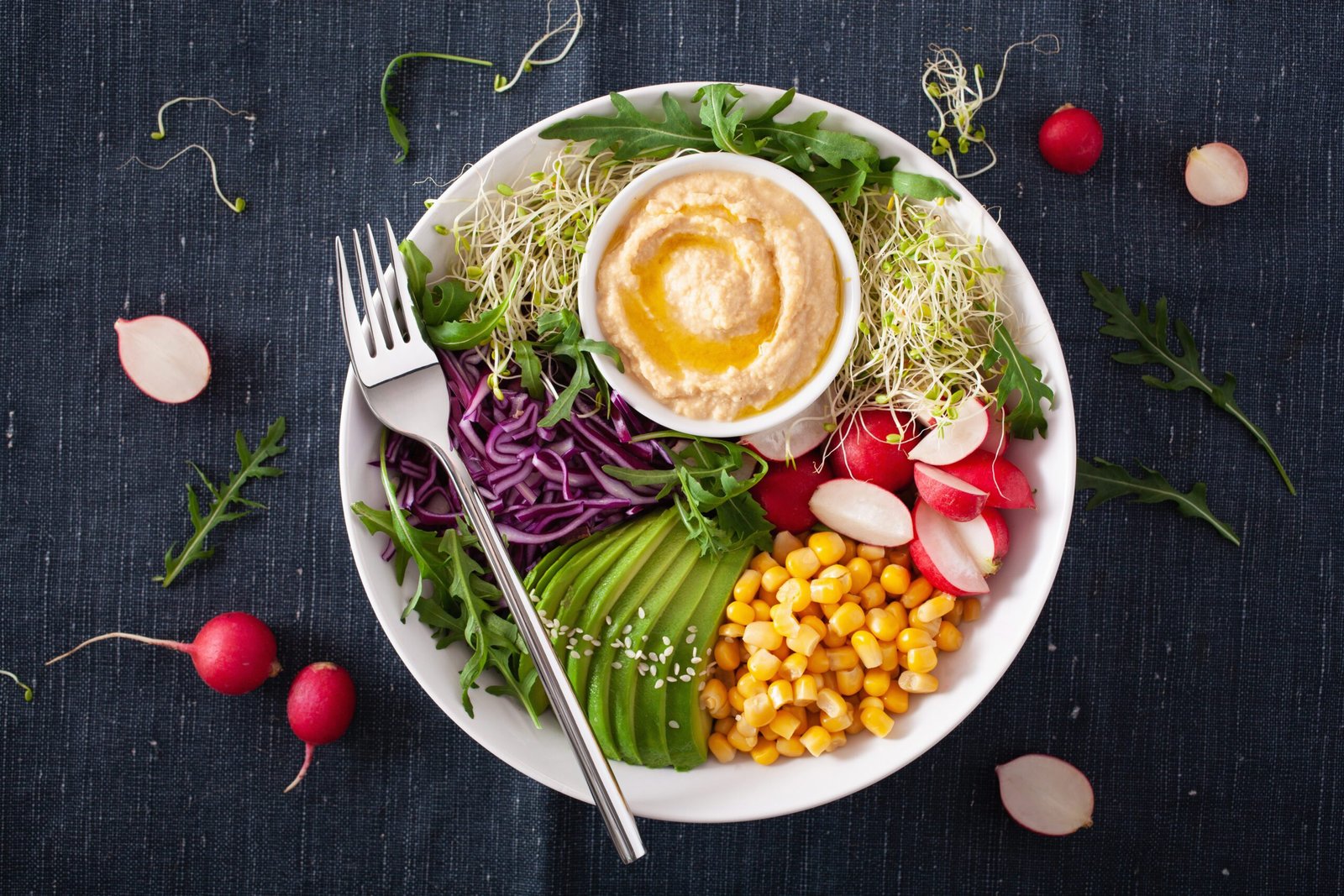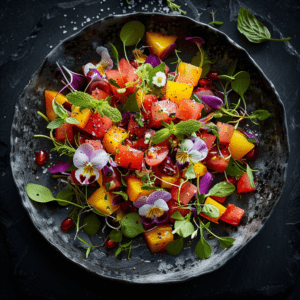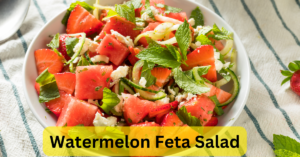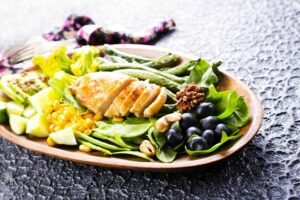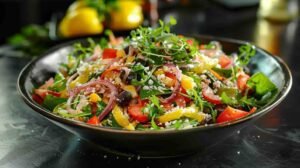Salad Toppings: Adding Flavour and Nutrition to Your Greens
Salad toppings are an essential part of any salad. Whether you are making a light side salad or a hearty meal, the right toppings can make all the difference. Salad toppings can add flavour, texture, and nutrition to your meal. The possibilities are endless, and there is a topping for every taste preference and dietary need.
When it comes to salad toppings, there are numerous options to choose from. From fruits and vegetables to nuts and seeds, the possibilities are endless. Some popular salad toppings include avocado, cherry tomatoes, cucumber, croutons, and bacon bits. For those looking for a healthier option, nuts and seeds can add a crunch while providing healthy fats and protein.
When choosing salad toppings, it is important to consider the nutritional value of each ingredient. Some toppings can be high in calories, fat, or sugar, while others can be low in nutrients. A balanced salad should include a variety of toppings that provide a range of nutrients, such as vitamins, minerals, fibre, and protein. By choosing the right toppings, you can create a delicious and nutritious salad that satisfies your taste buds and your body’s needs.
Types of Salad Toppings
When it comes to salad toppings, the options are endless. With so many different ingredients to choose from, it can be overwhelming to decide which ones to use. To help make the decision easier, this section will break down the different types of salad toppings into categories.
Vegetables
Vegetables are a great addition to any salad. They add flavour, texture, and nutrition. Some popular vegetable toppings include:
- Tomatoes: juicy and flavourful, tomatoes are a staple in many salads.
- Cucumbers: crisp and refreshing, cucumbers add a nice crunch to salads.
- Carrots: sweet and crunchy, carrots are a great source of vitamin A.
- Bell peppers: colourful and crunchy, bell peppers are a good source of vitamin C.
Fruits
Fruits can add a sweet and refreshing element to salads. Some popular fruit toppings include:
- Berries: strawberries, blueberries, raspberries, and blackberries are all great options.
- Apples: crisp and sweet, apples pair well with many different types of salads.
- Oranges: juicy and flavourful, oranges add a nice citrusy kick to salads.
- Grapes: sweet and juicy, grapes are a great addition to fruit salads.
Proteins
Proteins can help make salads more filling and satisfying. Some popular protein toppings include:
- Grilled chicken: flavourful and filling, grilled chicken is a great addition to salads.
- Hard-boiled eggs: a good source of protein, hard-boiled eggs add a nice texture to salads.
- Tuna: a good source of omega-3 fatty acids, tuna adds a nice flavour to salads.
- Beans: a good source of fibre and protein, beans are a great addition to vegetarian salads.
Cheeses
Cheeses can add a creamy and salty element to salads. Some popular cheese toppings include:
- Feta: tangy and salty, feta pairs well with many different types of salads.
- Goat cheese: creamy and tangy, goat cheese adds a nice flavour to salads.
- Cheddar: sharp and flavourful, cheddar is a good addition to salads with strong flavours.
- Parmesan: salty and nutty, parmesan adds a nice texture to salads.
Nuts and Seeds
Nuts and seeds can add a crunchy and nutty element to salads. Some popular options include:
- Walnuts: crunchy and slightly bitter, walnuts pair well with sweet salads.
- Almonds: crunchy and slightly sweet, almonds add a nice texture to salads.
- Sunflower seeds: nutty and flavourful, sunflower seeds are a good source of vitamin E.
- Pumpkin seeds: crunchy and slightly sweet, pumpkin seeds are a good source of magnesium.
In conclusion, there are many different types of salad toppings to choose from. By using a combination of vegetables, fruits, proteins, cheeses, and nuts and seeds, you can create a salad that is both delicious and nutritious.
Nutritional Value of Salad Toppings
When it comes to making a salad, choosing the right toppings can make all the difference. Not only do they add flavour and texture, but they also provide important nutrients. In this section, we will explore the nutritional value of some common salad toppings.
Vitamins and Minerals
Many salad toppings are rich in vitamins and minerals. For example, leafy greens like spinach, kale, and arugula are excellent sources of vitamin K, vitamin A, and folate. Adding sliced carrots, bell peppers, and tomatoes can provide a boost of vitamin C and potassium. Nuts and seeds, such as almonds and sunflower seeds, are also great sources of vitamins and minerals like vitamin E, magnesium, and zinc.
Macronutrients
In addition to vitamins and minerals, salad toppings can also provide important macronutrients like protein, carbohydrates, and healthy fats. Grilled chicken or tofu can add protein to a salad, while quinoa or chickpeas can provide both protein and carbohydrates. Avocado, olives, and nuts are all good sources of healthy fats that can help keep you feeling full and satisfied.
It is important to note that some salad toppings, such as croutons, bacon bits, and creamy dressings, can be high in calories, saturated fat, and sodium. To keep your salad healthy and balanced, it is best to choose toppings that are nutrient-dense and low in added sugars and unhealthy fats.
Overall, incorporating a variety of colourful fruits, vegetables, nuts, and seeds into your salad can help you meet your daily nutrient needs and support overall health and wellness.
Dressing and Sauces used for Salad Toppings
When it comes to salad toppings, dressing and sauces are essential to add flavour and moisture to the greens. There are many types of dressings and sauces available, and each one has its unique taste and texture.
Vinaigrettes
Vinaigrettes are a classic choice for salad dressing. They are made from oil, vinegar, and seasonings. The most common types of vinegar used in vinaigrettes are balsamic, red wine, and apple cider vinegar. Vinaigrettes are usually light and tangy, making them perfect for salads with delicate greens.
Creamy Dressings
Creamy dressings are thicker and richer than vinaigrettes. They are made from a base of mayonnaise, sour cream, or yogurt, and are often flavoured with herbs, spices, or cheese. Creamy dressings are perfect for salads with heartier greens like romaine or kale.
Oil-Free Options
For those looking for a healthier option, oil-free dressings are a great choice. These dressings are made from ingredients like hummus, tahini, or avocado, which provide a creamy texture without the use of oil. Oil-free dressings are perfect for those following a plant-based or low-fat diet.
In addition to these types of dressings, there are many other options available, such as honey mustard, ranch, and Caesar dressing. The key is to choose a dressing that complements the flavours of the salad toppings. For example, a sweet dressing like honey mustard pairs well with fruit and nut toppings, while a savoury dressing like ranch complements bacon and cheese toppings.
Herbs and Spices in Salad Toppings
Adding herbs and spices to a salad is an easy way to add flavour and depth to the dish. Here are some popular herbs and spices that can be used as salad toppings:
Fresh Herbs
Fresh herbs are a great way to add a burst of flavour to a salad. They can be used as a garnish or mixed into the salad itself. Some popular fresh herbs for salad toppings include:
- Basil: Adds a sweet and slightly spicy flavour to the salad.
- Cilantro: Adds a fresh and citrusy flavour to the salad.
- Dill: Adds a slightly sweet and tangy flavour to the salad.
- Mint: Adds a refreshing and cool flavour to the salad.
- Parsley: Adds a slightly bitter and earthy flavour to the salad.
Dried Spices
Dried spices are a convenient way to add flavour to a salad. They can be sprinkled on top of the salad or mixed into the dressing. Some popular dried spices for salad toppings include:
- Cumin: Adds a warm and slightly spicy flavour to the salad.
- Paprika: Adds a sweet and smoky flavour to the salad.
- Red pepper flakes: Adds a spicy and slightly sweet flavour to the salad.
- Rosemary: Adds a slightly bitter and piney flavour to the salad.
- Thyme: Adds a slightly sweet and earthy flavour to the salad.
When using herbs and spices as salad toppings, it’s important to use them in moderation. Too much of any herb or spice can overpower the other flavours in the salad. A general rule of thumb is to use about 1/4 to 1/2 teaspoon of dried spices or 1 to 2 tablespoons of fresh herbs per serving of salad.
Overall, herbs and spices are a great way to add flavour to a salad without adding extra calories or fat. They are also a great way to incorporate more nutrients into the dish.
Salad Topping Combinations
When it comes to salad toppings, the possibilities are endless. Some people prefer classic combinations, while others like to experiment with innovative pairings. Here are some ideas for both.
Classic Combinations
Classic salad toppings are tried and true, and they never go out of style. Here are some of the most popular combinations:
- Caesar Salad: Romaine lettuce, croutons, Parmesan cheese, and Caesar dressing.
- Greek Salad: Romaine lettuce, tomatoes, cucumbers, red onion, feta cheese, and Greek dressing.
- Cobb Salad: Romaine lettuce, bacon, hard-boiled eggs, avocado, tomatoes, chicken, and blue cheese dressing.
- Chef Salad: Mixed greens, ham, turkey, hard-boiled eggs, cheddar cheese, and ranch dressing.
Innovative Pairings
If you’re feeling adventurous, try some of these innovative salad topping pairings:
- Strawberry Spinach Salad: Baby spinach, sliced strawberries, crumbled goat cheese, and balsamic vinaigrette.
- Asian Salad: Mixed greens, mandarin oranges, sliced almonds, crispy wonton strips, and sesame dressing.
- Taco Salad: Mixed greens, seasoned ground beef, black beans, corn, tomatoes, shredded cheddar cheese, and salsa.
- Caprese Salad: Sliced tomatoes, fresh mozzarella, basil, and balsamic glaze.
The key to creating a delicious salad is to balance the flavours and textures of the ingredients. Don’t be afraid to mix and match different toppings until you find the perfect combination.
Dietary Considerations
When it comes to salads, there are a few dietary considerations to keep in mind. Here are some tips to help you create a salad that fits your dietary needs.
Vegetarian and Vegan Salad Toppings
For vegetarians and vegans, there are plenty of salad toppings to choose from. To add protein to your salad, consider adding beans, tofu, or tempeh. Nuts and seeds, such as almonds, pumpkin seeds, and sunflower seeds, are also great options. For a creamy dressing, try avocado or tahini-based dressings.
Gluten-Free
For those who are gluten-free, it’s important to avoid croutons and other wheat-based toppings. Instead, try adding gluten-free grains, such as quinoa or brown rice, to your salad. Other gluten-free toppings include nuts, seeds, fruits, and vegetables. Be sure to double-check the ingredients in dressings, as some may contain gluten.
Low-Carb and Keto
For those following a low-carb or keto diet, it’s important to avoid sugary dressings and high-carb toppings, such as croutons and sweet fruits. Instead, opt for low-carb vegetables, such as leafy greens, cucumbers, and bell peppers. Add healthy fats to your salad with avocado, nuts, and seeds. For a dressing, try a simple olive oil and vinegar dressing or a creamy dressing made with mayonnaise and sour cream.
Overall, there are plenty of salad toppings that fit a variety of dietary needs. By choosing the right toppings, you can create a delicious and healthy salad that meets your dietary goals.
Preparing and Storing Salad Toppings
Washing and Chopping
Before adding any toppings to the salad, it is important to wash them thoroughly. This ensures that any dirt or bacteria is removed. Rinse the toppings under cold, running water and use a vegetable brush to scrub them if necessary.
After washing, the toppings should be dried completely. Excess water can make the salad soggy. Use a salad spinner or pat them dry with a clean towel.
Chop the toppings into bite-sized pieces. This makes it easier to eat and ensures that each bite has a balanced number of toppings.
Storage Tips
To keep the toppings fresh, it is important to store them properly. Some toppings can be stored in the refrigerator for a few days while others need to be consumed immediately.
Here are some storage tips for common salad toppings:
- Leafy greens: Store them in a plastic bag with a paper towel to absorb any excess moisture. They can last for up to a week in the refrigerator.
- Tomatoes: Store them at room temperature, away from direct sunlight. They can last for a few days.
- Cucumbers: Store them in the refrigerator for up to a week.
- Avocado: Store it in the refrigerator once it is ripe. It can last for up to a week.
- Nuts and seeds: Store them in an airtight container in the refrigerator or freezer to prevent them from going rancid.
- Cheese: Store it in the refrigerator in an airtight container. Soft cheeses should be consumed within a few days while hard cheeses can last for a few weeks.
By following these tips, you can ensure that your salad toppings are fresh and delicious.
Presentation and Plating
When it comes to salads, presentation is just as important as taste. A visually appealing salad can elevate the dining experience and make it more enjoyable. In this section, we will discuss layering techniques and garnishing tips to help you create beautiful and appetizing salads.
Layering Techniques
Layering is a great way to add depth and texture to a salad. The key is to start with a bed of greens and then layer on other ingredients. Here are some layering techniques to consider:
- Vertical Stacking: This technique involves stacking ingredients vertically, creating a tower-like effect. It works best with sturdy ingredients like tomatoes, cucumbers, and avocado slices.
- Diagonal Layering: This technique involves layering ingredients diagonally across the plate. It creates a visually interesting pattern that adds depth to the salad.
- Nested Layering: This technique involves placing ingredients in a nested or criss-crossed pattern. It works well with thinly sliced vegetables like carrots and radishes.
Garnishing Tips while using Salad Toppings
Garnishes can add colour, texture, and flavour to a salad. Here are some garnishing tips to consider:
- Fresh Herbs: Adding fresh herbs like basil, cilantro, or mint can add a pop of colour and flavour to a salad.
- Crunchy Toppings: Adding crunchy toppings like croutons, nuts, or seeds can add texture and depth to a salad.
- Edible Flowers: Adding edible flowers like pansies or nasturtiums can add a touch of elegance and colour to a salad.
- Dressings: Drizzling dressings in a zig-zag pattern or in a small dish on the side can add a professional touch to the presentation.
By using these layering and garnishing techniques, you can create beautiful and appetizing salads that are sure to impress.
In essence, the journey through the world of salad toppings uncovers a realm of endless possibilities, where each ingredient holds the potential to transform a simple bed of greens into a culinary masterpiece. From the crunch of fresh vegetables to the richness of proteins and the tang of dressings, the right combination of toppings can elevate the humble salad to new heights of flavour and nutrition. Whether you’re seeking a light, refreshing bite or a hearty meal, the art of selecting and combining salad toppings offers a personalized dining experience that caters to every palate and dietary need. Embrace the diversity and creativity that salad toppings bring to the table, and let your next salad be an adventure in taste and texture.
Do read our other articles:
- Grilled Asparagus in Foil
- Best Air Fry Asparagus Recipe
- Healthy Oven Roasted Asparagus Recipe
- Can Dogs Eat Asparagus? 5 questions answered
FAQ’s
1. What Salad Dressing is Healthy?
Healthy salad dressings are often characterized by their inclusion of olive oil, vinegar, lemon juice, and a modest amount of salt and pepper. Consequently, these salad toppings are frequently chosen for their heart-healthy fats and minimal sugar content.
2. What Salad Dressing is Keto?
For a salad dressing to be considered keto, it needs to be high in fats and low in carbohydrates. As a result, dressings made with a base of olive oil, mayonnaise, or avocado oil, blended with vinegar or lemon juice, are typically selected as salad toppings by those adhering to a keto diet.
3. What Salad Dressing is OK for Acid Reflux?
Salad dressings that are low in fat and acidity are often recommended for individuals suffering from acid reflux. Therefore, dressings based on a light vinaigrette with reduced vinegar or lemon juice, or those made with herbs and a yogurt base, are commonly chosen as salad toppings.
4. What Salad Dressing is Gluten-Free?
Salad dressings that avoid ingredients like wheat, barley, or rye are deemed gluten-free. As such, many vinaigrettes and oil-based dressings, devoid of these ingredients, are preferred as salad toppings by those avoiding gluten.
5. What Salad Dressing is Low FODMAP?
To qualify as low FODMAP, salad dressings must omit high FODMAP ingredients like garlic and onion. Consequently, dressings made with garlic-infused oil, lemon juice, vinegar, and suitable herbs are often utilized as salad toppings by individuals following this dietary requirement.
6. What Salad Dressing is Keto Friendly?
Keto-friendly salad dressings, similar to keto dressings, are characterized by their high fat and low carbohydrate content. Hence, dressings containing healthy fats from sources like olive oil or avocado and minimal added sugars are favored as salad toppings.
7. What Salad Dressing is the Healthiest?
The healthiest salad dressings are generally those crafted from whole, natural ingredients such as olive oil, vinegar, lemon juice, and a variety of herbs and spices. Therefore, these types of dressings are often chosen as salad toppings for their absence of processed ingredients and additives.
8. What Salad Dressing is Vegan?
Vegan salad dressings are recognized by their exclusion of all animal products, including dairy, eggs, and honey. Accordingly, dressings based on olive oil, avocado, or tahini, mixed with vinegar or citrus juice, are popular salad toppings among vegans.
9. What Salad Dressing is Best for Acid Reflux?
Salad dressings that are easy on the stomach and low in acidity and fat are often deemed best for acid reflux. Thus, a light vinaigrette with minimal vinegar or a dressing made with non-citrus bases is commonly recommended as salad toppings.
10. What Salad Dressing is Low in Sodium?
Salad dressings that contain minimal added salt or salt substitutes are considered low in sodium. Therefore, dressings crafted from fresh ingredients like herbs, vinegar, and citrus juices without added salt are preferred as salad toppings by those monitoring sodium intake.
11. What Salad Dressing for Mediterranean Diet?
Salad dressings suitable for a Mediterranean diet are rich in healthy fats and derived from natural ingredients like olive oil, lemon juice, garlic, and herbs. Hence, these dressings are frequently chosen as salad toppings for their compatibility with the diet’s focus on whole foods.
12. What Salad Dressing is Best for Diabetics?
Salad dressings appropriate for diabetics are low in sugar and carbohydrates. As a result, dressings made with vinegar or lemon juice, olive oil, and minimal sweeteners are typically selected as salad toppings to prevent blood sugar spikes.
13. Are Salad Dressing Gluten-Free?
Salad dressings can be gluten-free, contingent upon their ingredients. Dressings devoid of wheat, barley, rye, or derivatives of these grains are considered gluten-free and are often labeled accordingly, making them suitable salad toppings for those avoiding gluten.
14. Are Salad Dressing Healthy?
Salad dressings can be healthy when formulated with nutritious ingredients and consumed in moderation. Thus, dressings that incorporate healthy fats, low sodium, and minimal added sugars are frequently regarded as beneficial salad toppings in a balanced diet.
15. Which are the Salad Toppings For Picky Eaters ?
Creating a salad for picky eaters involves sticking to familiar and well-loved ingredients. Start with a base of mild greens like romaine or iceberg lettuce. Add in toppings like sliced cucumbers, cherry tomatoes, shredded cheese, and diced ham or turkey. Croutons or a sprinkle of bacon bits can add a pleasing crunch and flavor that appeals to those with selective tastes.
16. Which are the Salad Toppings For Italian Dressing ?
Italian dressing pairs well with a variety of toppings, but to truly complement its flavors, consider classic Italian ingredients. Fresh mozzarella, ripe tomatoes, olives, and artichoke hearts embrace the essence of Italian cuisine. Adding grilled chicken or chickpeas can enhance the protein content, making the salad a more satisfying meal.
17. Which are the Salad Toppings For Weight Loss ?
For those focusing on weight loss, salad toppings should be both nutritious and low in calories. Incorporate plenty of fresh vegetables like spinach, kale, and tomatoes. Lean proteins such as grilled chicken, shrimp, or boiled eggs add substance without excess calories. Top your salad with a sprinkle of seeds or a handful of berries for a boost of flavor without derailing your goals.
